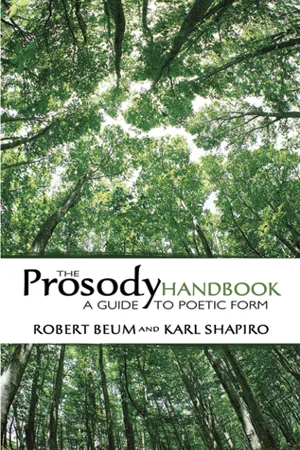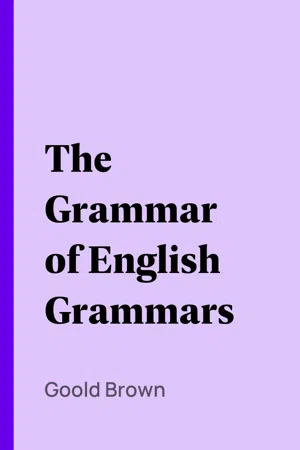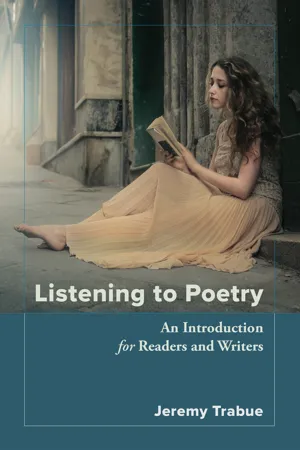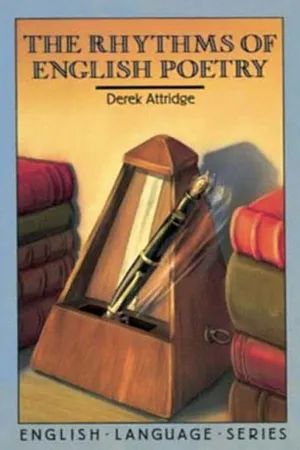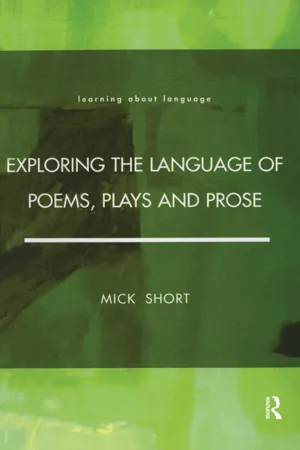Literature
Dactyl
A dactyl is a metrical foot in poetry consisting of one stressed syllable followed by two unstressed syllables. It is often used in classical poetry and can create a rolling, rhythmic effect. In English poetry, dactyls are less common than in classical verse but can still be found in certain forms and styles.
Written by Perlego with AI-assistance
5 Key excerpts on "Dactyl"
- eBook - ePub
The Prosody Handbook
A Guide to Poetic Form
- Robert Beum, Karl Shapiro(Authors)
- 2012(Publication Date)
- Dover Publications(Publisher)
iii ), where the dog is going at a merry clip, the speed of both trisyllabic feet is exploited: Dactylic in the first line, anapestic in the second. The Dactyl is probably even better suited to such comic and exuberant effects than to elegiac ones. Linguistic peculiarity and speed are no embarrassment in a light-hearted context.- (v) Hail to the brightness of Zion’s glad morning; Joy to the lands that in darkness have lain; Hushed be the accents of sorrow and mourning; Zion in triumph begins her mild reign.
The meter of these lines by Thomas Hastings is as banal as the language, which is hymnal cliché. The meter is perfectly regular, and such inflexibility is wooden enough in itself; but to make matters worse, this slick, pat, “commercial” rhythm is completely in conflict with the grandeur and masculine strength of the vision. The experience proposed is one of joy and exaltation, but the speed and abnormality of rhyming Dactylic meter can result only in hollow and pretty sentiment.SPONDAIC AND PYRRHICWhen stresses occur in succession, meaning almost always demands that some be heavier than others. Consequently, there are few or no true spondees in English verse. But notice in the lines above, from Yeats’s “Among School Children,” that the stresses on the syllables of the third and fourth feet of the first line, and of the fourth foot of the second line, are more nearly spondees than iambs. It is not really important, however, to be concerned about the feet. What is important is to notice that the four consecutive stresses (three primary and one secondary, perhaps) of the first line slow the rhythm to match the sense beautifully. The speaker, an old man who has come as a public official to inspect a school, is walking through a long - eBook - ePub
- Goold Brown(Author)
- 2004(Publication Date)
- Perlego(Publisher)
Dactyl.1. The Iambus, or Iamb, is a poetic foot consisting of a short syllable and a long one; as, b~etr=ay, c~onf=ess, d~em=and, ~intent, d~egr=ee.2. The Trochee, or Choree, is a poetic foot consisting of a long syllable and a short one; as, h=atef~ul, p=ett~ish, l=eg~al, m=eas~ure, h=ol~y.3. The Anapest is a poetic foot consisting of two short syllables and one long one; as, c~ontr~av=ene, ~acqu~i=esce, ~imp~ort=une.4. The Dactyl is a poetic foot consisting of one long syllable and two short ones; as, l=ab~our~er, p=oss~ibl~e, w=ond~erf~ul.These are our principal feet, not only because they are oftenest used, but because each kind, with little or no mixture, forms a distinct order of numbers, having a peculiar rhythm. Of verse, or poetic measure, we have, accordingly, four principal kinds, or orders; namely, Iambic, Trochaic, Anapestic, and Dactylic; as in the four lines cited above.The more pure these several kinds are preserved, the more exact and complete is the chime of the verse. But exactness being difficult, and its sameness sometimes irksome, the poets generally indulge some variety; not so much, however, as to confound the drift of the rhythmical pulsations: or, if ever these be not made obvious to the reader, there is a grave fault in the versification.The secondary feet, if admitted at all, are to be admitted only, or chiefly, as occasional diversifications. Of this class of feet, many grammarians adopt four; but they lack agreement about the selection. Brightland took the Spondee, the Pyrrhic, the Moloss, and the Tribrach. To these, some now add the other four; namely, the Amphibrach, the Amphimac, the Bacchy, and the Antibacchy - eBook - ePub
Listening to Poetry
An Introduction for Readers and Writers
- Jeremy Trabue(Author)
- 2019(Publication Date)
- Chemeketa Press(Publisher)
This funny little poem was written as a lesson for the poet’s son to teach him to recognize the metrical feet by showing them in action. If you read it out loud, it does give you good examples of how the different rhythms sound. The poet uses classical terminology here, referring to stressed syllables as “long” and unstressed as “short.”from “Metrical Feet” Trochee trips from long to short; From long to long in solemn sort Slow Spondee stalks, strong foot!, yet ill able Ever to come up with Dactyl’s trisyllable.5 Iambics march from short to long.With a leap and a bound the swift Anapests throng. Samuel Taylor Coleridge, 1806Let’s break it down into its constituent syllables and feet with the same highlighting we’ve been using. A vertical line separates each foot:Isn’t that clever? Every line describes the kind of foot it is exclusively made out of.Tro• chee |trips• from |long• to |short;From •long| to •long| in •sol| emn •sortSlow•Spon| dee •stalks, |strong•foot!, | yet •ill| a • bleEv• er • to |come• up • with |Dac• tyl’s • tri |syll• a • ble.I •am| bics •march| from •short| to •long.With • a •leap| and • a •bound| the • swift •An| a • pests •throng.The Line
Each line name is itself two parts. The second half of each is always “meter,” sensibly enough. The first half is the Greek word for a number:Monometer is a line of one foot.Dimeter is a line of two feet.Trimeter is a line of three feet.Tetrameter is a line of four feet.Pentameter is a line of five feet.Hexameter is a line of six feet.Heptameter is a line of seven feet.Octameter is a line of eight feet.People who think too hard about these categories disagree about whether or not a line longer than octameter is possible. At any rate, attempts at longer metrical lines are rare. It doesn’t happen in any traditional meters or forms. The most common lines in English are tetrameter and pentameter. - eBook - ePub
- Derek Attridge(Author)
- 2014(Publication Date)
- Routledge(Publisher)
This is not so, however, even within the literary tradition; while the four-beat line has often been used with this kind of variation (Coleridge’s ‘Christabel’ is perhaps the most self-conscious example), the pentameter has usually been distinguished by a more rigorous control of the number of syllables, its preference for duple rhythms and initial offbeats producing in strict metrical styles a count of ten, or eleven if a feminine ending is used, and only slightly more variety in freer styles. To understand this difference, we need to look a little more closely at the role of the syllable in the rhythms of English verse. While there are external reasons for the emphasis in different periods of literary history on a fixed syllable count, these cannot explain the success of this metrical principle in English; the achievements of Shakespeare, Spenser, Milton, and Wordsworth can hardly rest on a metre which is foreign to the language in which they wrote. It will be recalled that in Chapter 3 we found evidence for regarding the syllable as an elementary rhythmic unit of language, and it is likely, therefore, that apart from acting as the carrier of stress patterns and creating duple or triple rhythms, it can play a metrical role in its own right. The stress rhythm of English is too dominating for this role to be a major one, as it is in French verse, but we have already noted that the tendency towards isochrony in English is circumscribed by the rhythmic effect of the syllables between stresses - eBook - ePub
- Mick Short(Author)
- 2018(Publication Date)
- Routledge(Publisher)
But because the line lengths are now very irregular we do not feel that the rhythmic properties of each line are parallel to one another. It is this extra regularity which makes metre what it is. Metred poems, then, are poems where the line lengths and rhythmical patterns within the lines are close enough for us to feel a basic pattern of equivalence from line to line. This is why explaining how the different poetic metres work is an important aspect of explaining rhythm in poetry. 5.4 Different kinds of metre Metre in English verse is a level of organisation which is based upon a two—term contrast between positions in a line which should contain strong and weak syllables. Let us use the traditional terms ictus (/) and remiss (X) to refer to these strong and weak positions respectively. If we restrict ourselves for the moment to a situation where these two positions are only allowed to contain one syllable each, we can see that there are two possible patterns of weak and strong events, X /('di dum') and / X ('dum di'). These two elementary patterns are essential to an understanding of English metrics. The first pattern, X / ('di dum') is traditionally called the iamb and the / X ('dum di') pattern is called the trochee. The basic metrical unit of one strong plus one weak (ictus plus remiss) position is traditionally referred to as the metrical foot. Thus we can find iambic feet, trochaic feet, and also other combinations when the basic unit is expanded to include more than two syllables in the remiss of the foot (the metrical foot must have one and only one ictus syllable, but can normally have from zero to three remiss syllables). Below I list, with illustrative examples, the major foot structures that can be found with any regularity. Some are much more common than others, the iambic foot being by far the most widespread in English verse
Index pages curate the most relevant extracts from our library of academic textbooks. They’ve been created using an in-house natural language model (NLM), each adding context and meaning to key research topics.
Explore more topic indexes
Explore more topic indexes
1 of 6
Explore more topic indexes
1 of 4
